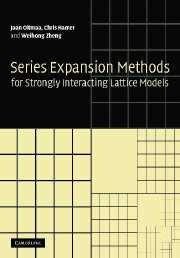Book contents
- Frontmatter
- Contents
- Preface
- 1 Introduction
- 2 High- and low-temperature expansions for the Ising model
- 3 Models with continuous symmetry and the free graph expansion
- 4 Quantum spin models at T = 0
- 5 Quantum antiferromagnets at T = 0
- 6 Correlators, dynamical structure factors and multi-particle excitations
- 7 Quantum spin models at finite temperature
- 8 Electronic models
- 9 Review of lattice gauge theory
- 10 Series expansions for lattice gauge models
- 11 Additional topics
- Appendix 1 Some graph theory ideas
- Appendix 2 The ‘pegs in holes’ algorithm
- Appendix 3 Free graph expansion technicalities
- Appendix 4 Matrix perturbation theory
- Appendix 5 Matrix block diagonalization
- Appendix 6 The moment–cumulant expansion
- Appendix 7 Integral equation approach to the two-particle Schrödinger equation
- Appendix 8 Correspondences between field theory and statistical mechanics
- Appendix 9 Computer programs
- Bibliography
- Index
5 - Quantum antiferromagnets at T = 0
Published online by Cambridge University Press: 06 January 2010
- Frontmatter
- Contents
- Preface
- 1 Introduction
- 2 High- and low-temperature expansions for the Ising model
- 3 Models with continuous symmetry and the free graph expansion
- 4 Quantum spin models at T = 0
- 5 Quantum antiferromagnets at T = 0
- 6 Correlators, dynamical structure factors and multi-particle excitations
- 7 Quantum spin models at finite temperature
- 8 Electronic models
- 9 Review of lattice gauge theory
- 10 Series expansions for lattice gauge models
- 11 Additional topics
- Appendix 1 Some graph theory ideas
- Appendix 2 The ‘pegs in holes’ algorithm
- Appendix 3 Free graph expansion technicalities
- Appendix 4 Matrix perturbation theory
- Appendix 5 Matrix block diagonalization
- Appendix 6 The moment–cumulant expansion
- Appendix 7 Integral equation approach to the two-particle Schrödinger equation
- Appendix 8 Correspondences between field theory and statistical mechanics
- Appendix 9 Computer programs
- Bibliography
- Index
Summary
Introduction: simple antiferromagnets
In the previous chapter we showed how to derive perturbation expansions for quantum spin models at T = 0, for both ground state bulk properties and for excitations. We used, as an example, the transverse field Ising model. This is arguably the simplest model to show a quantum phase transition. Moreover the model has a natural perturbation parameter, Γ/J or J/Γ, and the series are relatively straightforward to derive and interpret.
In the present chapter we turn to quantum antiferromagnets. These are systems in which the exchange interaction favours anti-alignment of neighbouring spins. The physics will turn out to be much richer, and we will use series methods to explore not only simple antiferromagnets on bipartite lattices but also the effects of frustration, competing interactions, destruction of antiferromagnetism due to singlet formation on dimers or plaquettes, and other related topics. With some minor modifications the techniques are the same as in Chapter 4. In this chapter, however, we will provide fewer details and concentrate more on results.
The Ising expansion
Let us start by considering a spin-½ system on a bipartite lattice, with nearest-neighbour antiferromagnetic exchange. A bipartite lattice is one which consists of two interpenetrating sub-lattices A, B such that the nearest neighbours of A spins all lie on sub-lattice B and vice versa. Examples are the linear chain, the square and honeycomb lattices in two dimensions, the simple cubic and body-centred cubic lattices in three dimensions.
- Type
- Chapter
- Information
- Publisher: Cambridge University PressPrint publication year: 2006

